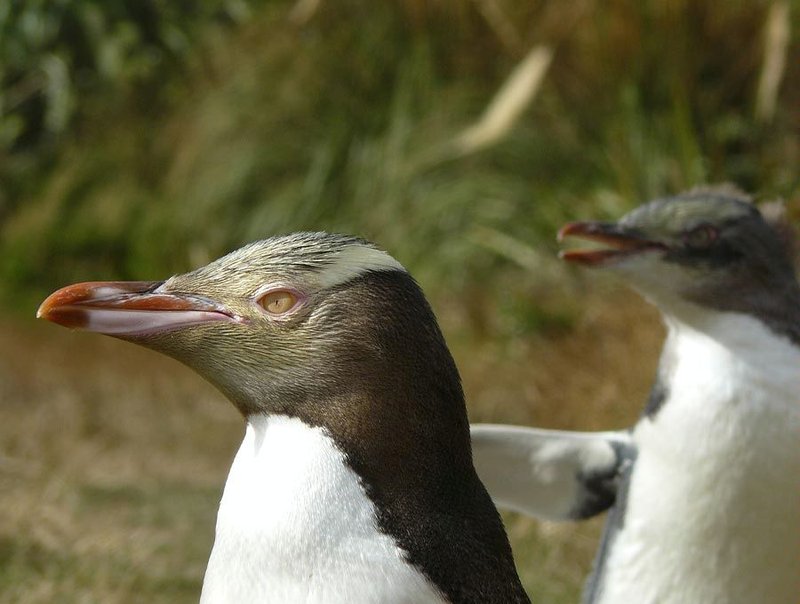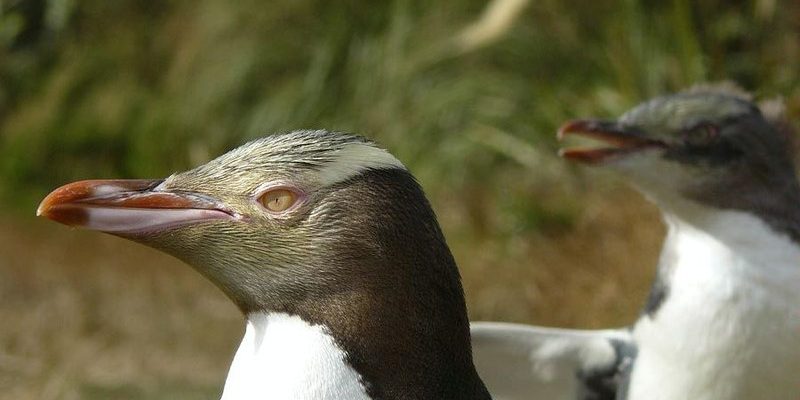
Imagine a bird that waddles like a little tuxedo-clad gentleman, with a quirky personality and an enchanting gaze that captivates anyone lucky enough to spot it. Meet the Yellow-Eyed Penguin, or as it’s called in its native New Zealand, the Hoiho. This charming creature is not just any penguin; it’s one of the rarest penguin species in the world. Found primarily along the southern coast of New Zealand, the Yellow-Eyed Penguin stands out with its striking yellow eyes and vivid yellow headbands that curve around its face.
Despite their endearing appearance, these penguins are quite vulnerable. Habitat loss, introduced predators, and environmental changes have reduced their numbers significantly, making conservation efforts crucial. So, if you’re curious about what makes the Yellow-Eyed Penguin special, and why we should care about their future, keep reading. We’ll dive deep into their habitat, behavior, diet, and the conservation efforts aimed at protecting them.
Physical Characteristics of the Yellow-Eyed Penguin
Starting with their look, the Yellow-Eyed Penguin is truly unique among penguins. Adults typically reach a height of about 65–75 cm (approximately 26–30 inches) and weigh around 3.5 to 8 kg (7.7 to 17.6 lbs). Their most distinctive feature is, of course, those bright yellow eyes. But what really sets them apart is the yellow band of feathers that sweeps back from their eyes, giving them a striking appearance that resembles a pair of funky sunglasses!
Their plumage is generally slate blue on the back, while their bellies are white. This coloration provides them with excellent camouflage while swimming in the ocean. When viewed from above, their blue back blends in with the water, and when seen from below, their white belly merges with the bright sky above. This dual coloration is an evolutionary trick that helps them evade predators and sneak up on their prey.
Young Yellow-Eyed Penguins, on the other hand, start off with a fluffy gray-brown down, which they shed as they grow older. It’s almost like they’re wearing a cozy blanket that keeps them warm before they transition into their adult plumage. Isn’t it fascinating how nature equips these birds for survival in such different stages of their lives?
Habitat and Distribution
Yellow-Eyed Penguins predominantly reside in New Zealand, particularly on the southeastern coasts of the South Island and around the Otago Peninsula. They prefer shaded forested areas, which provide cover from the sun and protection against predators. This unique preference for dense vegetation makes them somewhat reclusive compared to other penguin species that are more social.
These penguins often nest in burrows or under dense scrub, where they can safely raise their chicks away from prying eyes. The fact that they prefer secluded spots can make spotting them a thrilling challenge for wildlife enthusiasts. Imagine trudging through lush greenery, only to catch a glimpse of these delightful birds peeking out from their hides!
As coastal creatures, Yellow-Eyed Penguins also rely heavily on the surrounding ocean for their food. They generally forage in the waters around their breeding sites, which is essential for their survival. Their habitat is not just their home; it’s their lifeline. Unfortunately, as climate change and human activities put pressure on these coastal ecosystems, the future of the Yellow-Eyed Penguin hangs in a delicate balance.
Diet and Feeding Habits
The diet of the Yellow-Eyed Penguin mainly consists of fish, squid, and crustaceans. They are expert foragers, diving up to 100 meters (about 328 feet) deep to catch their dinner. They spend a good portion of their day hunting for food, and their preference leans towards local fish species like the mackerel and crested flounder.
What’s particularly interesting is their foraging behavior. Unlike other penguin species that hunt in groups, Yellow-Eyed Penguins tend to prefer solitary feeding. They’re like the introverts of the penguin world, comfortable on their own when it comes to hunting. They might spend hours fishing, only to return to their nests silently to feed their hungry chicks.
To give you a sense of their feeding efficiency, Yellow-Eyed Penguins can dive for about 2–3 minutes at a time before needing to surface for air. Their sharp eyesight helps them pick out their prey in the murky waters. And, here’s a fun fact: these penguins can consume up to a third of their body weight in a single meal! That’s a significant amount, considering their smaller size compared to other penguin species.
Breeding and Reproduction
When it comes to raising a family, the Yellow-Eyed Penguin is quite a devoted parent. Breeding season begins in August and extends to December. Males attract females through a series of displays, which often includes a characteristic courtship dance. It’s as if they’re trying to impress potential mates with their best moves!
After mating, females lay one to two eggs, typically in a nest made of grass and twigs. Interestingly, Yellow-Eyed Penguins are monogamous, sticking with the same partner for consecutive breeding seasons. Once the eggs hatch, both parents take turns caring for the chicks, protecting them from the cool weather and teaching them essential survival skills.
Those fluffy little chicks are utterly adorable, but they demand a lot of attention. For the first few weeks, they rely entirely on their parents for food. As they grow, they gradually begin to venture out of the nest and explore the world around them. This phase is exciting but also perilous, as they’re still vulnerable to predators. Observing these young birds learn and grow is a rewarding experience, offering a glimpse into the challenges of survival.
Conservation Status
The current status of the Yellow-Eyed Penguin is somewhat alarming. As of now, they are classified as “Endangered,” with estimates suggesting that their population has dropped to around 1,500 individuals. This decline is primarily attributed to habitat destruction, the introduction of non-native predators like cats and dogs, and the effects of climate change.
Conservation efforts are underway to protect these unique birds. Organizations are working diligently to restore their habitats, control predator populations, and monitor penguin nests. Community involvement is also key; local volunteers are crucial in raising awareness about the importance of preserving the Yellow-Eyed Penguin’s natural environment.
So, what can you do to help? If you live near their habitats or plan to visit, respect their space and avoid disturbing nesting sites. Supporting conservation programs and educating others about these remarkable animals can also make a significant impact. Remember, every small effort counts, and together we can make a big difference in their survival.
Facts and Quick Information
| Scientific Name: | Megadyptes antipodes |
| Size: | 65–75 cm (26–30 inches) |
| Weight: | 3.5 to 8 kg (7.7 to 17.6 lbs) |
| Diet: | Fish, squid, and crustaceans |
| Lifespan: | 15–20 years |
| Habitat: | Coastal areas of New Zealand |
| Conservation Status: | Endangered |
FAQ
What is the Yellow-Eyed Penguin’s natural habitat?
The Yellow-Eyed Penguin primarily inhabits the coastal areas of New Zealand, favoring forested regions close to the sea. These forested areas provide the shade and cover they need to protect themselves and their chicks from predators.
How is the Yellow-Eyed Penguin different from other penguin species?
One of the most striking differences is the Yellow-Eyed Penguin’s unique facial markings and solitary feeding habits. Unlike many other penguins that thrive in colonies, Yellow-Eyed Penguins prefer to forage alone, which makes them quite distinctive.
What threats do Yellow-Eyed Penguins face?
Yellow-Eyed Penguins face several threats, including habitat loss due to human development, introduced predators like cats and rats, and climate change impacting their food supply. Pollution and fishing practices can also affect their well-being.
How do Yellow-Eyed Penguins care for their young?
Both parents share the responsibility of feeding and protecting the chicks. They typically lay one or two eggs, and once the chicks hatch, they depend on their parents for food and safety until they are ready to venture out and learn to swim.
Are Yellow-Eyed Penguins social animals?
No, Yellow-Eyed Penguins are generally solitary creatures. They don’t form large colonies like some other penguin species, preferring to hunt and nest away from the crowd, which adds to their unique charm.
How long do Yellow-Eyed Penguins live?
In the wild, Yellow-Eyed Penguins can live anywhere from 15 to 20 years, provided they can avoid the various threats they face in their environment. However, their life expectancy can be significantly affected by factors like conservation efforts and habitat preservation.
What do conservationists do to help Yellow-Eyed Penguins?
Conservationists focus on multiple strategies, including habitat restoration, predator control, and community engagement. They monitor nesting sites, educate the public about the importance of these birds, and create protected areas to ensure that Yellow-Eyed Penguins can thrive.
Can you see Yellow-Eyed Penguins in the wild?
Yes, but it requires some effort! They are endemic to New Zealand, particularly on the Otago Peninsula. Wildlife tours often take visitors to spots where these penguins can be observed, but it’s crucial to respect their natural habitat and maintain a safe distance.
What do Yellow-Eyed Penguins eat?
Yellow-Eyed Penguins primarily consume fish, squid, and crustaceans. Their diet is crucial for their growth and energy needs, and they often dive deep into the ocean to catch their meals.
Why are Yellow-Eyed Penguins considered endangered?
They are classified as endangered due to their declining population, driven by habitat destruction, predation from non-native species, and the impact of climate change. Significant efforts are necessary to protect their remaining habitats and ensure their survival.
What makes the Yellow-Eyed Penguin special?
The Yellow-Eyed Penguin is unique due to its striking appearance, solitary nature, and vulnerability. Their distinct yellow bands and eyes set them apart from other penguins, while their critical conservation status urges us to pay attention to their plight.

